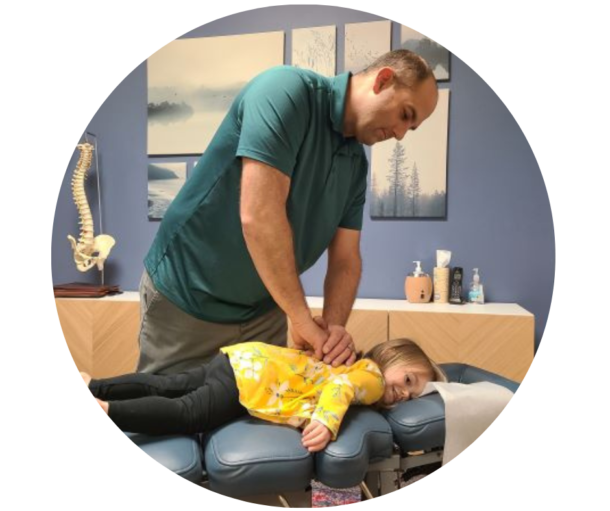Lower Back Pain
When people think of chiropractic care, lower back pain usually comes to mind. People that will come into our clinic will say: “I don’t know what happened, I just bent down to pick up something off of the floor when my back went out,” or “I bent forward and felt something pop in my lower back, and that is when the pain began.” Often times before coming to see a chiropractor, people will try to rest their lower back, or take some sort of pain medications to help. When the pain is not getting any better, then they will seek chiropractic treatment. When you experience pain, this is your body’s way of telling you that something is wrong, and that you need to be evaluated. Obviously there are exceptions to this, like general muscle soreness from doing yardwork, soreness after exercising…etc. Often times when you ignore your pain for too long, it can take longer to get you back to feeling better, so it is important to see your chiropractor when you feel that something is wrong.
Most lower back pain comes from a problem in the joints of the spine and the surrounding muscles. When a joint of the lower back becomes “stuck” in a certain position, this will cause the surrounding muscles to tighten and inflammation around the area resulting in pain and/or numbness/tingling. Since chiropractors focus on biomechanics (movement) of the spine, we can “free up” these restricted joints, allowing better movement and less pain. Chiropractors treat many different conditions resulting from problems with the joints, muscles and nerves, but lower back pain is one of the conditions we see most often.
How do chiropractors treat lower back pain? By adjusting the lower back and pelvis, allowing the joints to move better (we have several techniques to accomplish this) and using techniques to loosen the muscles, reducing inflammation (electric stimulation, ultrasound…etc). When the joints are moving better and the muscles are less tense, this will help to reduce inflammation (which is the major contributor to lower back pain).
There are things that you may be doing at work or at home that are contributing to your lower back pain. Having good form when bending forward is important. You should try to avoid excessive twisting motions (especially bending forward and twisting at the same time). Always bend at the knee and/or keep your back flat (not rounded) while bending forward. Also, be aware of when your lower back pain started and ask yourself questions like: did you recently get a new mattress? Recently went on a long car ride? Changed jobs with different types of job responsibilities? Started a new exercise routine? Some of these questions may help in solving how to help your lower back pain.
When should you be concerned:
There are less common, but serious conditions that lead to lower back pain that need medical attention. Infections that cause lower back pain involving the bones of the lower back, although not common, is referred to as osteomyelitis (1). Infections can begin in the bone after an injury exposes the area to bacteria and other pathogens. Symptoms of osteomyelitis are fever, swelling, pain and fatigue. People at risk include recent surgeries, diabetics, smokers, and people in kidney failure (2).
Tumors can spread to the lower back, causing pain that can appear with symptoms as common lower back. Unexplained weight loss is one sign to raise concern, or pain that wakes you up at night. An x-rays, MRI or CT scan can be used to detect tumors in the spine (1).
Cauda equina syndrome is a complication of a ruptured disc that compresses nerves of the lower back and will cause a loss of bowel and bladder control. This is a serious condition that if not immediately treated, can lead to permanent nerve damage (1).
Abdominal aortic aneurysms (AAA) is a condition when the large blood vessel of the abdomen, pelvis, and legs becomes enlarged and can rupture (1). This blood vessel can weaken and dilate like a balloon. Every year approximately 200,000 people in the US are diagnosed with this condition. This condition runs in families and if you have a first degree relative that has had an AAA, you are about 12 times more likely to have this condition. Other risk factors include smoking history, high blood pressure, and tobacco use. In most cases there are no symptoms associated with this condition and are found when being examined for another medical condition. When symptoms occur, they will present with a sudden onset of pain in the back or abdomen and could mean that you have had an AAA and about to rupture and you need to seek immediate medical care (3).
If back pain is not reducing with conservative treatment, then further tests and images would be recommended to diagnose a more serious condition causing your lower back pain.
Statistics and Facts:
- Back pain is the single leading cause of disability in the world
- Back pain is one of the most common reasons for people missing work
- Up to 80% of the population will have back pain
- Back pain is the third most common reason office visits at the doctor’s office
- Most lower back pain is caused by joints and muscles (mechanical)
- Low back pain costs at least $50 billion for Americans in health care cost every year
- According to the Agency for Health Care Research and Quality, spinal manipulation is recommended as the only safe and effective, drug free form of initial professional treatment for acute lower back problems in adults
- A clinical trial with 750 active duty members of the military showed that chiropractic care combined with medical care provides greater pain relief and reduction is disability than medical care alone (4)
Exercises:
Yoga and gentle stretches can help to ease lower back pain by increasing flexibility in the spine and stretching the muscles. It is also important to be aware of your body while doing yoga, and if you experience any pain, stop doing that particular exercise. Yoga stretching is not meant to be painful. Yoga will help to stretch tight muscles and increase movement to tight joints that contribute to painful symptoms.
A contributing factor to your lower back pain might be related to a weakness in your core muscles. The muscles around your stomach (abdominal muscles) help to stabilize your lower back, and when these muscles are weak they can place more stress on the lower back (causing pain). Traditional sit-ups have been shown to be stressful on the lower back and not recommended. Instead of sit-ups, choose to do crunches (similar to sit-ups but your lower back remains on the floor and only your upper back and shoulders come off the ground). Plank exercises can also help to strengthen your lower back, but can be stressful on your shoulders.
Studies have shown a decrease in flexibility of the muscles of the hips can contribute to lower back pain. The reason behind this is because when your hips are tight, your lower back will try to compensate. This demand on your lower back will increase the stress to the joints and muscles, resulting in pain. There are a series of stretches the you can do to increase the muscles of the hips and improve your lower back pain. One muscle of your hips (called the iliopsoas) that is responsible for lifting your knee toward your chest (hip flexor) anatomically attaches to your joints of your lower back, as well as, your hip. When this muscle tightens it can cause hip and/or lower back pain.
Chiropractic treatment for lower back pain and other forms of natural treatment:
Chiropractic treatments have a high success rate for improving lower back pain by increasing range of motion of the joints and decreasing muscle tension and inflammation. Most people will notice an immediate improvement on the first treatment! We have several different techniques to help patients get better, including very gentle techniques for people who do not want the traditional chiropractic treatments. We also will educate patients on the best exercises for their particular condition based on examinations.
Combined approaches typically have the best results when using chiropractic treatments with massage therapy, physical therapy, and/or acupuncture. These types of therapies use different approaches to help stretch, loosen, and remove trigger points (tight areas of muscles).
Structural problems:
We are supposed to have a forward curve in our lower back to reduce stress on the joints; however, this curve can be decreased (hypolordosis) or increased (hyperlordosis) and this can result in chronic lower pain. There is a technique in chiropractic called chiropractic biophysics (CBP) that can help to reshape these curves and help with pain. This technique uses special foam blocks to encourage the optimal curve for the lower back (and other areas of the spine). Before and after x-rays have shown results through research studies of this technique.
A short leg and lower back pain? That’s right! Many people have an imbalance with their leg length. This can be due to a knee or hip replacement (structural), tight muscles in the pelvis, an injury to the muscles of one side of the body, a cast that was worn on the foot (without balancing the other side), a fracture when a person was young through the growth plate of the bone (causing uneven development of the leg), a slip/fall causing dysfunction in the joints of the pelvis/lower back, or many other reasons. Whatever the reason may be, this imbalance of having a short leg can cause lower back pain (also can cause knee and hip pain). Getting an evaluation by either a chiropractor or podiatrist can help to determine if a heel lift or orthotic insert can help to correct this structural problem. When the leg length is balanced, this can reduce or even eliminate the lower back pain and other symptoms.
References:
1.) National Institute of Neurological Disorders and Stroke. March 16, 2020.
2.) Osteomyelitis. Mayo clinic staff. Nov 16, 2018.
3.) Singh, Michael. Abdominal Aortic Aneurysm. Society for Vascular Surgery.



Recent Comments